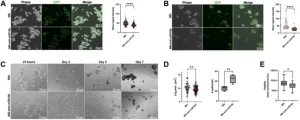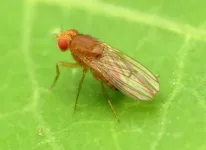(Press-News.org)
More than 50% of ride-hailing trips taken by surveyed riders in California replaced more sustainable forms of transportation — such as walking, cycling, carpooling, and public transit — or created new vehicle miles, according to a study from the University of California, Davis Institute of Transportation Studies.
The study was conducted to help guide development of the Clean Miles Standard, a state regulation designed by the California Air Resources Board to reduce the greenhouse gas emissions from ride-hailing services.
Published in Transportation Research Record: Journal of the Transportation Research Board, the study analyzed data collected among riders in three metropolitan regions — the San Francisco Bay Area, San Diego, and Los Angeles and Orange counties — between Nov. 2018 and Nov. 2019. The data set consisted of 7,333 ride-hailing trips by 2,458 respondents.
About 47% of the trips replaced a public transit, carpool, walking or cycling trip. An additional 5.8% of trips represented “induced travel,” meaning the person would not have made the trip were an Uber or Lyft unavailable. This suggests ride-hailing often tends to replace most sustainable transportation modes and leads to additional vehicle miles traveled.
Equity issues
The study also found that respondents who did not have a household car, or who identified as a racial or ethnic minority, were the least likely to cancel a trip if ride-hailing was not available. This indicates that their Uber or Lyft ride was an essential, not discretionary trip, although the authors say this finding requires more research.
“Hopefully, the results of this study can be used to increase the sustainability of ride-hailing and also address potential equity issues that are apparent,” said lead author James Giller, a Ph.D. candidate at the Institute of Transportation Studies at UC Davis.
At their best, ride-hailing services can connect people to mobility opportunities they may otherwise not have had, ideally while saving emissions and reducing traffic when the vehicle is electric and the ride is shared. When not used sustainably, however, such services can also increase traffic, reduce the use of public transit — an economical and sustainable mode of transportation for a variety of income levels — and increase social inequities.
Recommendations for sustainable ride-hailing
To improve sustainability, the study recommends ride-hailing trips — especially those offered by shared, or pooled, services—be better connected to public transit in low-demand areas, so they complement those services rather than replace them.
“There’s certainly a place for ride-hailing and opportunities to improve its sustainability,” Giller said. “It’s all about making sure it’s used in the most efficient way by increasing the occupancy of the vehicles; by making sure these trips connect people to transit stations for longer distance travel; that they’re done in efficient, clean cars; and that we can reduce as much as possible the inefficiencies associated with finding passengers and going to pick them up.”
Study coauthors include senior author Giovanni Circella of the UC Davis Institute of Transportation Studies and Mischa Young of the Université de l’Ontario français in Canada.
"This study helps inform agencies on the role that ride-hailing has in complementing versus substituting the use of other travel modes,” Circella said. “The study is particularly unique due to the richness of the data used. While the data were collected before the pandemic, and thus might refer to different market conditions, the research helps establish an important benchmark that will help policymakers improve the sustainability of passenger travel as part of efforts to decarbonize transportation in California and beyond."
The study was funded primarily by the California Air Resources Board. Additional funding was provided by the 3 Revolutions Future Mobility Program of UC Davis.
END
Half of Uber, Lyft trips replace more sustainable options
Study suggests ways to make ride-hailing more sustainable and equitable
2024-08-28
ELSE PRESS RELEASES FROM THIS DATE:
miR-10b Inhibition: A strategy for treating metastatic breast cancer
2024-08-28
“We have developed a nanodrug, termed MN-anti-miR10b, that delivers anti-miR-10b antisense oligomers to cancer cells.”
BUFFALO, NY- August 28, 2024 – A new research paper was published in Oncotarget's Volume 15 on August 26, 2024, entitled, “Inhibition of miR-10b treats metastatic breast cancer by targeting stem cell-like properties.”
As stated within the Abstract of the paper, despite advances in breast cancer screening and treatment, the prognosis for metastatic disease remains dismal, with ...
Love is blind for male fruit flies who will choose sex over safety
2024-08-28
Male fruit flies will become oblivious to physical danger as they become more engaged in courtship and sex, new research shows.
Researchers at the University of Birmingham have shown that pursuit of a coveted reward – in this case a female fly – will cause a male fruit fly to ignore threats such as predation.
In the study, published today (28 Aug) in Nature, the team was able to show for the first time the neural networks in the fly’s brain that direct this decision-making process, revealing the neurotransmitter dopamine has a leading role to play.
Lead researcher Dr Carolina Rezaval said: “Every day we make decisions that require us to ...
Kidney donors’ risk of death at all-time low
2024-08-28
The risk of death for people who donate a kidney for transplantation — already small a decade ago — has dropped by more than half since then, a new study shows.
Each year, roughly 6,000 Americans volunteer to donate a kidney, according to the Organ Procurement and Transplantation Network. Before undergoing the procedure, donors are informed of the potential risks, including death. Based on data from 1995 through 2009, experts had originally predicted that about three of every 10,000 donors were likely to die within three months of the procedure. The authors of the ...
Thirty-year trends in perioperative mortality risk for living kidney donors
2024-08-28
About The Study: Perioperative mortality after living donation declined substantially in the past decade compared with prior decades, to fewer than 1 event per 10,000 donations. Risk was higher for male donors and donors with a history of hypertension. Current guidelines for donor informed consent, based on 2009 data, should be updated to reflect this information.
Corresponding Author: To contact the corresponding author, Dorry L. Segev, MD, PhD, email dorry.segev@nyulangone.org.
To access the embargoed study: Visit our For The Media website at this link https://media.jamanetwork.com/
(doi:10.1001/jama.2024.14527)
Editor’s Note: Please ...
Intersection of poverty and rurality for early-onset colorectal cancer survival
2024-08-28
About The Study: Patients with early-onset colorectal cancer (defined as colorectal cancer diagnosed in individuals younger than 50 years) living in rural areas had lower 5-year survival rates than their urban dwelling counterparts in this study. While it was not observed consistently for all age groups, persistent poverty in these rural areas may compound this association.
Corresponding Author: To contact the corresponding author, Meng-Han Tsai, PhD, metsai@augusta.edu.
To access the embargoed study: Visit our For The Media website at this link https://media.jamanetwork.com/
(doi:10.1001/jamanetworkopen.2024.30615)
Editor’s Note: Please ...
First-generation antihistamines and seizures in young children
2024-08-28
About The Study: Prescriptions for first-generation antihistamines were associated with a 22.0% higher seizure risk in children, especially in those ages 6 to 24 months in this cohort study. These findings emphasize the need for careful and judicious prescription of first-generation antihistamines in young children and underline the need for further research to elucidate associations between antihistamine prescriptions and seizure risk.
Corresponding Authors: To contact the corresponding authors, email Seonkyeong Rhie, MD, (starclusters@gmail.com) and Man Yong Han, MD, (drmesh@gmail.com).
To ...
Prioritizing the unexpected: New brain mechanism uncovered
2024-08-28
Researchers have discovered how two brain areas, neocortex and thalamus, work together to detect discrepancies between what animals expect from their environment and actual events. These prediction errors are implemented by selective boosting of unexpected sensory information. These findings enhance our understanding of predictive processing in the brain and could offer insights into how brain circuits are altered in autism spectrum disorders (ASDs) and schizophrenia spectrum disorders (SSDs).
The research, published today in Nature, outlines how scientists at the Sainsbury Wellcome Centre at UCL studied mice in a virtual reality ...
More people at risk of hereditary heart disease than thought
2024-08-28
More people in the UK are at risk of a hereditary form of cardiac amyloidosis, a potentially fatal heart condition, than previously thought, according to a new study led by researchers at UCL (University College London) and Queen Mary University of London.
The study, published in JAMA Cardiology, used data from the UK Biobank to analyse the genes of 469,789 people in the UK and found that one in 1,000 possessed genetic variants with a likely link to cardiac transthyretin (ATTR) amyloidosis.
Among ...
Breaking open the AI black box, team finds key chemistry for solar energy and beyond
2024-08-28
CHAMPAIGN, Ill. — Artificial intelligence is a powerful tool for researchers, but with a significant limitation: The inability to explain how it came to its decisions, a problem known as the “AI black box.” By combining AI with automated chemical synthesis and experimental validation, an interdisciplinary team of researchers at the University of Illinois Urbana-Champaign has opened up the black box to find the chemical principles that AI relied on to improve molecules for harvesting solar energy.
The result produced light-harvesting molecules four times more stable than ...
Discovery of how blood clots harm brain and body in COVID-19 points to new therapy
2024-08-28
In a study that reshapes what we know about COVID-19 and its most perplexing symptoms, scientists have discovered that the blood coagulation protein fibrin causes the unusual clotting and inflammation that have become hallmarks of the disease, while also suppressing the body’s ability to clear the virus.
Importantly, the team also identified a new antibody therapy to combat all of these deleterious effects.
Published in Nature, the study by Gladstone Institutes and collaborators overturns the prevailing ...
LAST 30 PRESS RELEASES:
The Ceramic Society of Japan’s Oxoate Ceramics Research Association launches new international book project
Heart-brain connection: international study reveals the role of the vagus nerve in keeping the heart young
Researchers identify Rb1 as a predictive biomarker for a new therapeutic strategy in some breast cancers
Survey reveals ethical gaps slowing AI adoption in pediatric surgery
Stimulant ADHD medications work differently than thought
AI overestimates how smart people are, according to HSE economists
HSE researchers create genome-wide map of quadruplexes
Scientists boost cell "powerhouses" to burn more calories
Automatic label checking: The missing step in making reliable medical AI
Low daily alcohol intake linked to 50% heightened mouth cancer risk in India
American Meteorological Society announces Rick Spinrad as 2026 President-Elect
Biomass-based carbon capture spotlighted in newly released global climate webinar recording
Illuminating invisible nano pollutants: advanced bioimaging tracks the full journey of emerging nanoscale contaminants in living systems
How does age affect recovery from spinal cord injury?
Novel AI tool offers prognosis for patients with head and neck cancer
Fathers’ microplastic exposure tied to their children’s metabolic problems
Research validates laboratory model for studying high-grade serous ovarian cancer
SIR 2026 delivers transformative breakthroughs in minimally invasive medicine to improve patient care
Stem Cell Reports most downloaded papers of 2025 highlight the breadth and impact of stem cell research
Oxford-led study estimates NHS spends around 3% of its primary and secondary care budget on the health impacts of heat and cold in England
A researcher’s long quest leads to a smart composite breakthrough
Urban wild bees act as “microbial sensors” of city health.
New study finds where you live affects recovery after a hip fracture
Forecasting the impact of fully automated vehicle adoption on US road traffic injuries
Alcohol-related hospitalizations from 2016 to 2022
Semaglutide and hospitalizations in patients with obesity and established cardiovascular disease
Researchers ‘listen in’ to embryo-mother interactions during implantation using a culture system replicating the womb lining
How changing your diet could help save the world
How to make AI truly scalable and reliable for real-time traffic assignment?
Beyond fragmented markets: A new framework for efficient and stable ride-pooling
[Press-News.org] Half of Uber, Lyft trips replace more sustainable optionsStudy suggests ways to make ride-hailing more sustainable and equitable





